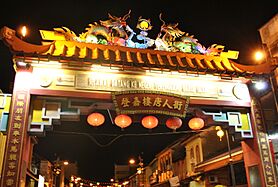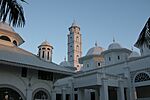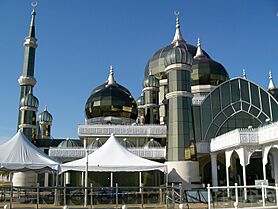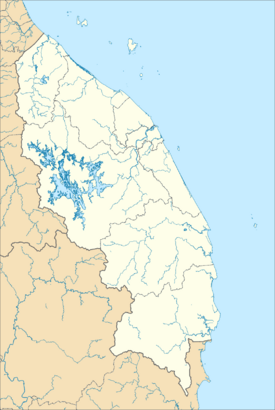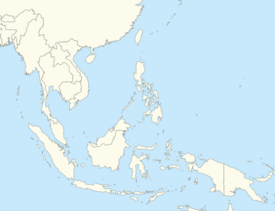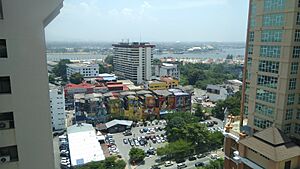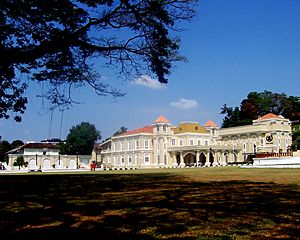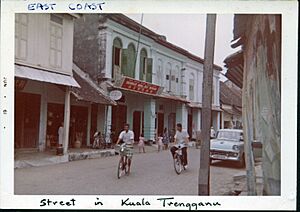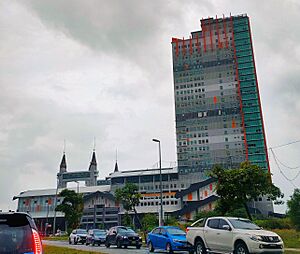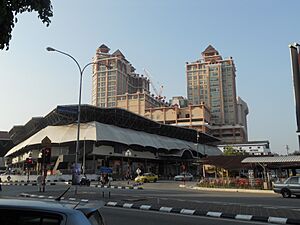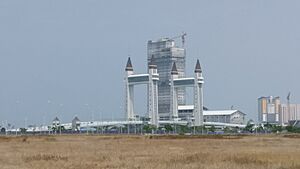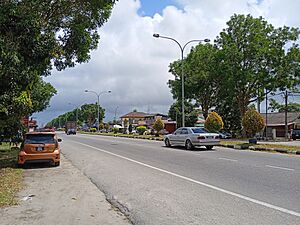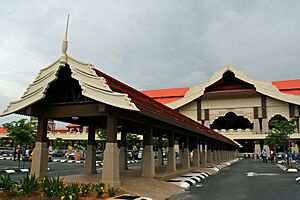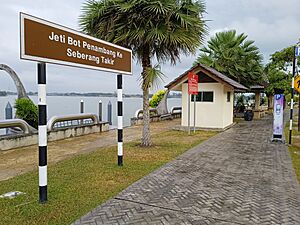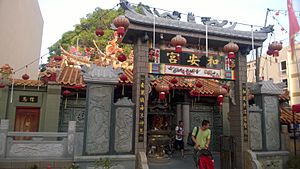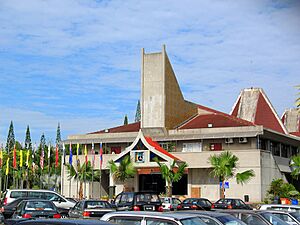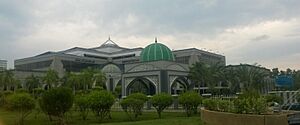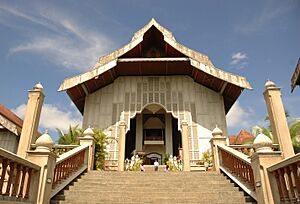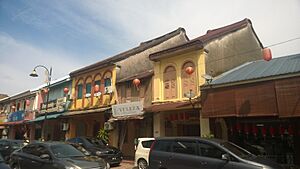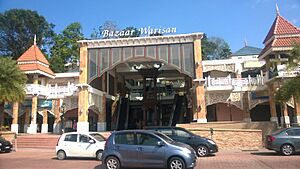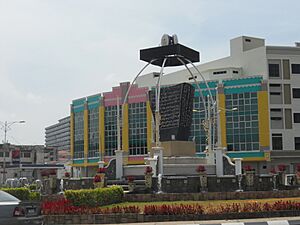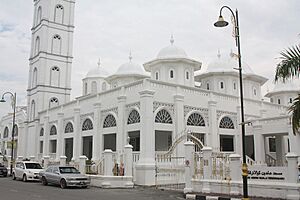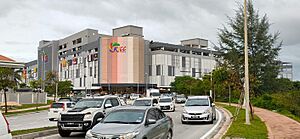Kuala Terengganu facts for kids
Quick facts for kids
Kuala Terengganu
Kole Tranung
|
|||
|---|---|---|---|
|
State capital city, royal capital and district capital
|
|||
| City of Kuala Terengganu Bandaraya Kuala Terengganu |
|||
| Other transcription(s) | |||
| • Jawi | كوالا ترڠڬانو | ||
| • Chinese | 瓜拉登嘉楼 (Simplified) 瓜拉登嘉樓 (Traditional) Guālā-dēngjiālóu (Hanyu Pinyin) |
||
| • Tamil | கோலா திராங்கானு Kōlā Tirāṅkāṉu (Transliteration) |
||
|
From top, left to right:
The Kuala Terengganu skyline, Chinatown, city view from Duyong Island, the Abidin Mosque, and the Syarqiyyah Palace, The Crystal Mosque |
|||
|
|||
| Nickname(s):
KT
|
|||
| Motto(s):
Bandaraya Warisan Pesisir Air
English: Waterfront Heritage City |
|||
| Country | |||
| State | |||
| Districts | Kuala Terengganu Kuala Nerus |
||
| Administrative areas |
List
|
||
| Establishment of the local government | 1928 | ||
| Establishment of the Town Board | 1950 | ||
| Establishment of the Town Council | 1972 | ||
| Municipality status | 18 January 1979 | ||
| City status | 1 January 2008 | ||
| Government | |||
| • Type | City council | ||
| • Body | Kuala Terengganu City Council | ||
| Area | |||
| • Total | 605 km2 (233.59 sq mi) | ||
| Elevation | 15 m (49 ft) | ||
| Population
(2020)
|
|||
| • Total | 375,424 (1st) | ||
| • Density | 705/km2 (1,830/sq mi) | ||
| • Demonym | Kuala Terengganuan | ||
| Time zone | UTC+8 (MST) | ||
| • Summer (DST) | Not observed | ||
| Postal code |
20xxx
|
||
| Area code(s) | 09-6xxxxxxx | ||
| Vehicle registration | T | ||
Kuala Terengganu, often called KT, is the main city and royal capital of the state of Terengganu, Malaysia. It is located on the east coast of Peninsular Malaysia, about 440 kilometers northeast of Kuala Lumpur. The city sits where the Terengganu River meets the South China Sea.
Even though it's the smallest district in size, Kuala Terengganu and the nearby Kuala Nerus District together have the largest population in Terengganu. In 2020, about 375,424 people lived here. Kuala Terengganu became a city on January 1, 2008, and is known as the "Waterfront Heritage City."
Besides being important for politics and business, Kuala Terengganu is also the main entry point for tourists visiting Terengganu. Popular places to see include Kampung Cina, Pasar Besar Kedai Payang (Central Market), the Terengganu State Museum, and Batu Buruk Beach. The city mixes modern life with strong Malay traditions and other cultures from its long history as a port.
Contents
What's in a Name?
In the Malay language, the word kuala means "river mouth" or "where rivers meet." So, Kuala Terengganu means "the mouth of the Terengganu River," where it flows into the South China Sea.
There are a few ideas about how the name Terengganu came about. One story says it comes from terang ganu, which means 'bright rainbow' in Malay. Another popular story was told by Baginda Omar, the ninth Sultan of Terengganu. It's about hunters from Pahang who found a large animal fang on the ground. When asked what animal it belonged to, a hunter replied, taring anu (Malay for 'fang of something'). Later, when people asked where they found their treasures, they said "from the land of taring anu." This name then changed over time to Terengganu.
A Glimpse into History
Early Chinese writings mention a state called Tan-Tan that sent gifts to China. This state was likely in the Terengganu area. Later, Terengganu was influenced by powerful empires like Srivijaya and Majapahit. In the 15th century, it came under the Malacca Sultanate.
When the Malacca Sultanate fell in 1511, the new Sultanate of Johor took over many of its lands, including Terengganu. For a short time in the 1600s, the Aceh Sultanate had control, but Johor regained its influence later.
The Terengganu Sultanate Begins
The current Sultanate of Terengganu began in 1708. The first Sultan, Sultan Zainal Abidin I, moved his court several times before settling in Kuala Terengganu. In the early 1700s, Kuala Terengganu was a small town. About half of its people were Chinese, who worked in farming and trade.
After Sultan Daud passed away in 1831, there was a short civil war for the throne. Tengku Omar was defeated but later returned in 1839 to reclaim the throne, becoming Sultan Omar.
In 1862, the British asked for an ex-Sultan from another state to be removed from Terengganu. When Sultan Omar refused, British ships attacked Kuala Terengganu. The Sultan and the ex-Sultan fled during the attack.
A big fire in 1882 destroyed many buildings in Kuala Terengganu, including the Sultan's palace, Green Palace. The Maziah Palace was built to replace it. Kuala Terengganu remained the capital even when it was under Siam and later, British rule.
British Rule and World War II
Terengganu came under British control in 1909. It was part of the "Unfederated Malay States." The British ruled until the Japanese took over during World War II. On December 18, 1941, Japanese forces moved into Kuala Terengganu. Later, in 1943, Thailand took control of Terengganu as part of a deal with the Japanese. After the war, the British regained control.
Modern Times
In 1957, Malaya became independent. In 1963, Malaya, North Borneo (now Sabah), Sarawak, and Singapore formed Malaysia. Kuala Terengganu became a city on January 1, 2008.
How the City is Governed
The Kuala Terengganu City Council manages the city. This council covers both the Kuala Terengganu District and the Kuala Nerus District. The city is important for the state's politics and economy. It has many government offices and is also the royal capital, home to the Sultan's palaces like Istana Badariah and Istana Maziah.
Kuala Terengganu was first set up as a local government area in 1928. Over the years, its size grew. In 1979, the Kuala Terengganu Municipal Council (MPKT) was formed. On January 1, 2008, Kuala Terengganu became the first city on the East Coast of Peninsular Malaysia. The Municipal Council then changed its name to Kuala Terengganu City Council (MBKT).
In 2014, the northern part of Kuala Terengganu became a new district called Kuala Nerus. However, both Kuala Terengganu and Kuala Nerus are still managed by the same City Council (MBKT). This makes MBKT one of the few local governments in Malaysia that manages two different districts.
The MBKT is in charge of public health, waste management, town planning, and maintaining city services. Its main office is at Menara Permint. Kuala Nerus has seen a lot of growth, especially in higher education and housing. It is home to Universiti Malaysia Terengganu and Universiti Sultan Zainal Abidin. The Sultan Mahmud Airport and Sultan Mizan Zainal Abidin Stadium are also in Kuala Nerus.
City Landscape and Weather
Kuala Terengganu has sandy beaches along its eastern side facing the South China Sea. The western part of the district has hills. Most of the city is low-lying land, which is good for farms like paddy fields and rubber plantations. The city also has a few higher spots, including Bukit Besar and Bukit Puteri.
Climate and Monsoons
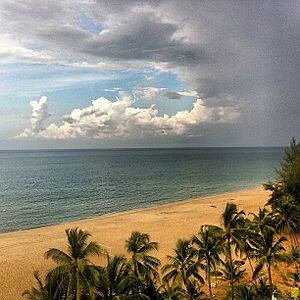
Kuala Terengganu has a tropical rainforest climate. This means it's generally hot and humid all year round, with temperatures around 28°C to 30°C during the day. The sea breeze helps to make the coastal areas feel cooler.
There are two main monsoon seasons. The southwest monsoon is from May/June to September. The northeast monsoon is from November to March. During the northeast monsoon, Kuala Terengganu gets heavy rainfall. The sea can be very rough, so it's not a good time for island trips or sea activities. However, some days can still be sunny and clear. The city gets about 2,911 millimeters of rain each year.
Who Lives Here?
| Ethnic groups in Kuala Terengganu – 2010 PBT Census | ||||
|---|---|---|---|---|
| Ethnic | Percent | |||
| Malay | 94.74% | |||
| Chinese | 3.44% | |||
| Foreigners | 1.28% | |||
| Indian | 0.25% | |||
| Other Bumiputeras | 0.19% | |||
| Others | 0.08% | |||
In the 19th century, there were many Malays and some Chinese living in Kuala Terengganu. Most houses were made of wood. The Chinese area, Kampung Cina, had older buildings made of stone and brick. There were also Arabs living in the city.
In 2010, Kuala Terengganu had a population of 406,317. Most people were Malays (about 319,813). Chinese residents were the second largest group (11,617). Other groups included foreigners, other native groups, and Indians. By 2020, the population was around 375,424.
Religions and Languages
Most people in Kuala Terengganu are Muslim (96.9%). Other religions include Buddhist (2.5%), Hindu (0.2%), and Christian (0.2%). All Malays are Muslim. Chinese residents mostly practice Buddhism, Taoism, or Christianity.
Terengganu Malay is the main language spoken by Malays in the city. Some also speak Kelantanese. Chinese residents mostly speak Hokkien, with some speaking Teochew and Mandarin. Most Indians speak Tamil. Standard Malay and English are also widely understood.
Economy and Business
Kuala Terengganu used to be a big fishing and trading port. It exported goods like coffee, gold, pepper, and tin. In return, it imported rice, tobacco, and cotton.
Today, Kuala Terengganu's economy includes small factories. These make traditional textiles, local foods, arts and crafts. There are also bigger industrial areas in Chendering and Gong Badak. Factories that make bricks or wood products are usually outside the main city. Tourism is also a very important part of Kuala Terengganu's economy.
Getting Around the City
Public Transport
You can get around Kuala Terengganu using taxis and buses. The Kuala Terengganu Bus Terminal has local bus services and long-distance coaches to other cities in Malaysia and Singapore. There's also a special "Town Bus" service, called Bas Bandar, which has a unique roof design like a traditional Malay house.
You can still find trishaws, which are like bicycle taxis. They are mostly used by tourists now. While there's no train service yet, the East Coast Rail Link (ECRL) project will connect Kuala Terengganu to other cities by train in the future. Kuala Terengganu was also the first city on the East Coast to have a public bicycle-sharing system called oBike.
Roads and Bridges
The Sultan Mahmud Bridge is a three-kilometer bridge that connects the two sides of the Terengganu River. Two other bridges, Manir Bridge and Pulau Sekati Bridge, also cross the river. A new bridge, the Kuala Terengganu Drawbridge, opened in 2019. It's the first of its kind in Malaysia and connects the city center to Seberang Takir.
Kuala Terengganu is well-connected by roads. The East Coast Expressway (LPT) makes it faster to drive from Kuala Lumpur, taking about four hours. You can also use Federal Route 3 for a scenic drive along the coast.
Air Travel
The closest airport is Sultan Mahmud Airport (TGG), located in the neighboring Kuala Nerus District. It has flights to other Malaysian cities and some international routes. Airlines like Malaysia Airlines, Firefly, AirAsia, and Malindo Air fly here. The airport can handle 2 million passengers each year.
Water Taxis
Water taxis, known as bot penambang, travel along the Terengganu River. They connect the northern and southern parts of the city, making it easy to cross the river. There are also modern ferry services to islands like Redang from Syahbandar Jetty.
Public Services
Law and Order
Kuala Terengganu has various courts, including the High Court and Syariah Court. The main police headquarters for Terengganu is in Kuala Terengganu. There are also smaller police stations around the city. The main fire station is near Bukit Kecil.
Healthcare Services
The main hospital in Kuala Terengganu is Sultanah Nur Zahirah Hospital (HSNZ). It is the largest hospital in the state. There are also private hospitals like Kuala Terengganu Specialist Hospital and SALAM Specialist Hospital. Many smaller health clinics are available throughout the district.
Places of Worship
There are many mosques in Kuala Terengganu. Famous ones include Abidin Mosque, also known as Masjid Putih (White Mosque), and Tengku Tengah Zaharah Mosque, often called the 'floating mosque' because it's built over water.
The city also has two Chinese temples, Ho Ann Kiong Temple and Tian Hou Gong Temple, located near Chinatown. There are also Presbyterian and Anglican churches, and a Catholic church. For Hindus, there is the Sri Kali Yuga Durga Lakshmi Aman Temple.
Learning and Education
Kuala Terengganu is a center for higher education in Terengganu. It has three public universities: Universiti Sultan Zainal Abidin, Universiti Malaysia Terengganu, and Universiti Teknologi MARA Chendering campus. There are also other colleges and training institutes.
For younger students, there are 81 primary schools and 34 secondary schools. Examples include SMK Chung Hwa Wei Sin and Sekolah Menengah Sains Sultan Mahmud.
Libraries for Everyone
The Terengganu State Library is the largest library in the state. It's a main resource center for people of all ages. Smaller village libraries are also available in areas like Seberang Takir.
Fun Things to Do
Historical Places to Visit
The Terengganu State Museum in Kampung Losong is one of the largest museum complexes in Malaysia. Its design is based on traditional Terengganu Malay houses. It has many galleries, including a Maritime Gallery and an Islam Gallery. The museum is also home to the Terengganu Inscription Stone, the oldest artifact with Jawi writing in Malaysia.
Near the museum is the Islamic Heritage Park. This park has replicas of famous mosques from around the world, like Al-Masjid al-Haram and the National Mosque of Malaysia. The Crystal Mosque is also located here.
Bukit Puteri is a small hill near Pasar Payang. It was once a fort used by the sultans. You can find old artifacts and monuments there. During the holy month of Ramadan, a century-old brass bell is rung from the hill to signal the end of fasting for the day.
Cultural Experiences
Chinatown, Kuala Terengganu (also called Kampung Cina) is a main tourist attraction. It has old shophouses, some dating back to the 1700s. These buildings now house shops, coffee shops, and restaurants. Chinatown also has two Chinese temples and a 19th-century water well that still provides clean water. Many back alleys have been turned into themed lanes with murals and decorations.
Pasar Besar Kedai Payang, or Central Market, is the city's main market. It sells fresh food, traditional snacks, clothes, and handicrafts like batik and songket. Pulau Duyong is an island known for traditional boat making. It also has a historical monument called Kota Lama Duyong.
Relaxing Spots
Kuala Terengganu has many places to relax. Batu Buruk Beach is close to the city center and offers activities like horse riding and kite flying. However, it's not safe to swim due to strong waves. Taman Shahbandar is another park by the Terengganu River, near Pasar Payang and Bukit Puteri.
Other recreational spots include:
- Kuala Terengganu Waterfront: Offers views of Pulau Duyong and Sultan Mahmud Bridge.
- Taman Awam Lagun Kuala Ibai: A park where the Tengku Tengah Zaharah Mosque is located.
- Taman Awam Pantai Teluk Ketapang: A beach and park near Sultan Mahmud Airport.
Other Interesting Sights
The Abidin Mosque is Kuala Terengganu's old royal mosque, built between 1793 and 1808. It's also known as Masjid Putih (White Mosque). Seberang Takir is a fishing village across the river, reachable by bot penambang. Here, you can see how local foods like keropok lekor (fish crackers) and batik are made.
A giant replica of the Terengganu Inscription Stone is displayed on a roundabout in Jalan Sultan Ismail.
Delicious Food

You must try Keropok lekor, a local fish cracker, especially the famous keropok lekor Losong. Other traditional dishes include nasi dagang, laksam, laksa Terengganu, otak-otak, sata, and pulut lepa. In Kampung Cina, you can find Peranakan Chinese food, which mixes Malay and Chinese cooking styles.
Media and News
Kuala Terengganu receives most Malaysian TV channels and radio stations. The state's own radio station, Terengganu FM, and private stations like Hot FM Teganu and Manis FM, operate from the city.
Major Malaysian newspapers are available, including English, Malay, Chinese, and Tamil dailies. Local newspapers like Sinar Harian also provide regional news.
Sports and Recreation
Kuala Terengganu has two main stadiums: Sultan Ismail Nasiruddin Shah Stadium in the city center and Sultan Mizan Zainal Abidin Stadium in Gong Badak. These are home to the state's football teams, Terengganu FA and T-Team FC.
The Sultan Mizan Zainal Abidin Stadium complex was built for the 2008 Malaysian Games. It has facilities for various sports like hockey, lawn bowls, and bowling. Kuala Terengganu has hosted many sporting events, including the Monsoon Cup sailing race and stages of the Le Tour de Langkawi cycling race.
Global Connections
Kuala Terengganu has an honorary consulate for Kazakhstan.
Sister Cities
Kuala Terengganu has two sister cities:
 Makassar, Indonesia.
Makassar, Indonesia. Des Moines, Iowa, United States.
Des Moines, Iowa, United States.
See also
 In Spanish: Kuala Terengganu para niños
In Spanish: Kuala Terengganu para niños


